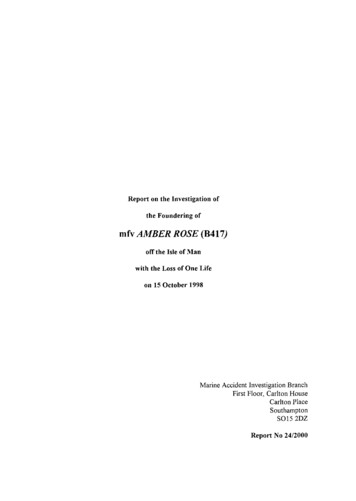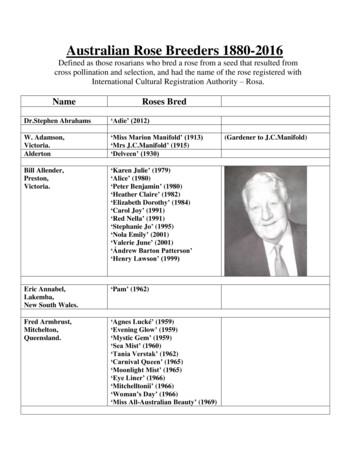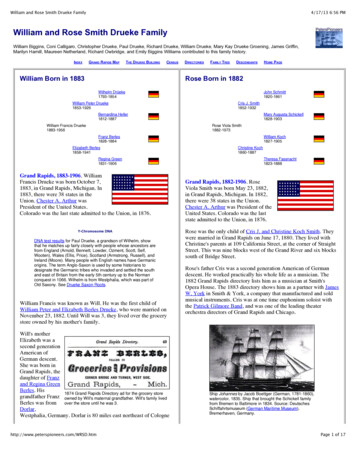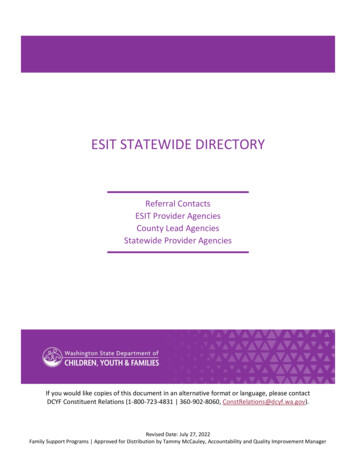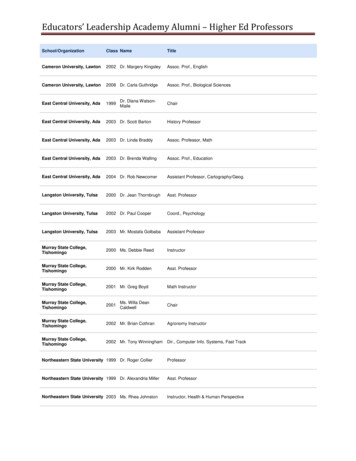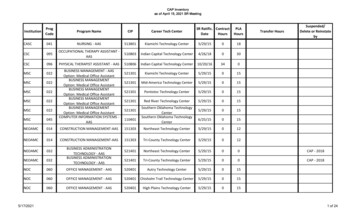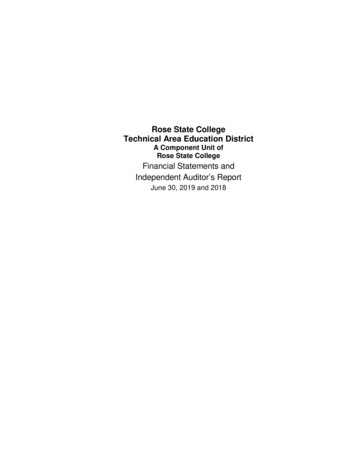
Transcription
Rose State CollegeTechnical Area Education DistrictA Component Unit ofRose State CollegeFinancial Statements andIndependent Auditor’s ReportJune 30, 2019 and 2018
Rose State CollegeTechnical Area Education DistrictA Component Unit of Rose State CollegeJune 30, 2019 and 2018ContentsIndependent Auditor’s Reporton Financial Statements . 1Management’s Discussion and Analysis (unaudited) . 3Financial StatementsStatements of Net Position . 8Statements of Revenues, Expenses, and Changes in Net Position . 9Statements of Cash Flows . 10Notes to Financial Statements . 12Independent Auditor’s Report on Internal Control OverFinancial Reporting and on Compliance and Other MattersBased on an Audit of the Financial Statements Performed inAccordance with Government Auditing Standards . 20
INDEPENDENT AUDITOR’S REPORTBoard of TrusteesRose State College Technical Area Education DistrictMidwest City, OklahomaReport on the Financial StatementsWe have audited the accompanying financial statements of Rose State College Technical Area Education District(the “District”) a component unit of Rose State College, as of and for the years ended June 30, 2019 and 2018,and the related notes to the financial statements, which collectively comprise the District’s basic financialstatements as listed in the table of contents.Management’s Responsibility for the Financial StatementsManagement is responsible for the preparation and fair presentation of these financial statements in accordancewith accounting principles generally accepted in the United States of America; this includes the design,implementation, and maintenance of internal control relevant to the preparation and fair presentation of financialstatements that are free from material misstatement, whether due to fraud or error.Auditor’s ResponsibilityOur responsibility is to express an opinion on these financial statements based on our audits. We conducted ouraudits in accordance with auditing standards generally accepted in the United States of America and the standardsapplicable to financial audits contained in Government Auditing Standards, issued by the Comptroller General ofthe United States. Those standards require that we plan and perform the audit to obtain reasonable assuranceabout whether the financial statements are free from material misstatement.An audit involves performing procedures to obtain audit evidence about the amounts and disclosures in thefinancial statements. The procedures selected depend on the auditor’s judgment, including the assessment of therisks of material misstatement of the financial statements, whether due to fraud or error. In making those riskassessments, the auditor considers internal control relevant to the entity’s preparation and fair presentation of thefinancial statements in order to design audit procedures that are appropriate in the circumstances, but not for thepurpose of expressing an opinion on the effectiveness of the entity’s internal control. Accordingly, we express nosuch opinion. An audit also includes evaluating the appropriateness of accounting policies used and thereasonableness of significant accounting estimates made by management, as well as evaluating the overallpresentation of the financial statements.We believe that the audit evidence we have obtained is sufficient and appropriate to provide a basis for our auditopinion.OpinionIn our opinion, the financial statements referred to above present fairly, in all material respects, the financialposition of the District as of June 30, 2019 and 2018, and the changes in its financial position and its cash flowsfor the years then ended in accordance with accounting principles generally accepted in the United States ofAmerica.309 N. Bryant Ave. Edmond, OK 73034 405.348.0615 Fax 405.348.0931 www.jmacpas.comMember of AICPA and OSCPA
Other MattersRequired Supplementary InformationAccounting principles generally accepted in the United States of America require that the management’sdiscussion and analysis, as listed in the table of contents, be presented to supplement the basic financialstatements. Such information, although not a part of the basic financial statements, is required by theGovernmental Accounting Standards Board, who considers it to be an essential part of financial reporting forplacing the basic financial statements in an appropriate operational, economic, or historical context. We haveapplied certain limited procedures to the required supplementary information in accordance with auditingstandards generally accepted in the United States of America, which consisted of inquiries of management aboutthe methods of preparing the information and comparing the information for consistency with management’sresponses to our inquiries, the basic financial statements, and other knowledge we obtained during our audit of thebasic financial statements. We do not express an opinion or provide any assurance on the information because thelimited procedures do not provide us with sufficient evidence to express an opinion or provide any assurance.Other Reporting Required by Government Auditing StandardsIn accordance with Government Auditing Standards, we have also issued our report dated October 28, 2019, onour consideration of the District’s internal control over financial reporting and on our tests of its compliance withcertain provisions of laws, regulations, contracts, and grant agreements and other matters. The purpose of thatreport is to describe the scope of our testing of internal control over financial reporting and compliance and theresults of that testing, and not to provide an opinion on internal control over financial reporting or on compliance.That report is an integral part of an audit performed in accordance with Government Auditing Standards inconsidering the District’s internal control over financial reporting and compliance.October 28, 2019
Rose State College Technical Area Education DistrictA Component Unit of Rose State CollegeManagement’s Discussion and AnalysisFor the Years Ended June 30, 2019 and 2018Management’s Discussion and AnalysisThe discussion and analysis of Rose State College’s Technical Area Education District’s (the“District”) financial statements provides an overview of the District’s financial activities for theyears ending June 30, 2019 and 2018. Since this management’s discussion and analysis isdesigned to focus on current activities, resulting changes and current known facts, please readit in conjunction with the District’s financial statements and footnotes. A comparative analysis ofthe prior two years financial data is provided.These statements include all assets and liabilities using the accrual basis of accounting. All ofthe current year’s revenues and expenses are recognized when earned or incurred, regardlessof when cash is received or paid.Financial HighlightsStatement of Net Position and Statement of Revenues, Expenses, and Changes inNet PositionThe Statement of Net Position and the Statement of Revenues, Expenses, and Changes in NetPosition report the District’s net position and how it has changed. Net Position is one way tomeasure the District’s health. Over time, increases or decreases in the District’s net position canbe an indicator of whether or not its financial health is improving. Non-financial factors are alsoimportant to consider.The table below is prepared from the District’s Statement of Net Position, and summarizes theDistrict’s assets, liabilities, and net position in thousands at June 30, 2019, with comparativetotals at June 30, 2018 and 2017.Current assetsNoncurrent assetsCapital assets, net of depreciationTotal assets 201912,715 201810,335 ent liabilitiesNoncurrent liabilitiesTotal 18,60021,761Net positionNet investment in capital assetsRestricted for capital projectsRestricted for debt serviceUnrestrictedTotal net 65,76426,54517,1521,4072,1715,39326,123 3
Rose State College Technical Area Education DistrictA Component Unit of Rose State CollegeManagement’s Discussion and AnalysisFor the Years Ended June 30, 2019 and 2018Financial Highlights (Continued)Statement of Net Position and Statement of Revenues, Expenses, and Changes inNet Position (Continued)At year end June 30, 2019, capital assets decreased by approximately 3,702,000 from theyear ended June 30, 2018 due to the sale of land and annual calculation of depreciationexpense on existing assets.At year end June 30, 2018, capital assets decreased by approximately 1,831,000 from theyear ended June 30, 2017 due to the annual calculation of depreciation expense on existingassets.The table below is prepared from the District’s Statement of Revenues, Expenses, and Changesin Net Position in thousands for the year ended June 30, 2019, with comparative totals for theyears ended June 30, 2018 and 2017.2019Operating expenses 20184,255Nonoperating revenues (expenses)Ad Valorem taxesAcademic support for the Mid-Del AreaVocational Technical SchoolInvestment incomeInterest expense 20174,285 )(4,690)22(851)Net nonoperating revenues6,9696,5566,430Income before other 95)Other revenues/expensesIncrease in net position 6814 422 841
Rose State College Technical Area Education DistrictA Component Unit of Rose State CollegeManagement’s Discussion and AnalysisFor the Years Ended June 30, 2019 and 2018Financial Highlights (Continued)Statement of Net Position and Statement of Revenues, Expenses, and Change inNet Position (Continued)ExpensesOperating expenses held fairly steady in fiscal year 2019. This is after an increase in 2018 dueto increased depreciation expense from capital assets placed in service during the year.The table below summarizes the District’s operating expenses in thousands for the year endedJune 30, 2019, with comparative totals for the years ended June 30, 2018 and 2017.Contractual servicesSupplies and materialsUtilitiesDepreciationOtherTotal Operating Expenses201720182019 6031183522,322860 5781144972,342754 5811235601,851879 4,255 4,285 3,994Non-Operating RevenueNon-operating revenues, as reported above, for fiscal 2019 reflect an increase in ad valoremtaxes collected compared to fiscal 2018 and fiscal 2017. Interest expense decreased in fiscalyear 2019 compared to fiscal 2018. Likewise, the fiscal 2018 results reflect a decrease ininterest expense compared to fiscal 2017.5
Rose State College Technical Area Education DistrictA Component Unit of Rose State CollegeManagement’s Discussion and AnalysisFor the Years Ended June 30, 2019 and 2018Financial Highlights (Continued)Statement of Cash FlowsThe primary purpose of the Statement of Cash Flows is to provide information about the cashreceipts and disbursements of the District during a period. This statement also aids in theassessment of an entity’s ability to generate future net cash flows, ability to meet obligations asthey come due, and needs for external financing.The table below is prepared from the District’s Statement of Cash Flows, and summarizes theDistrict’s cash flows in thousands for the year ended June 30, 2019, with comparative totals forthe years ended June 30, 2018 and 2017.2019Cash provided by (used in):Operating activitiesNoncapital financing activitiesCapital and related financing activitiesInvesting activities (2,074)4,799(429)79Net change in cashCash, beginning of yearCash, end of year2018 2017(2,391)3,290(690)352,3752449,9479,70312,322 (3,137)2,965(4,448)22 (4,598)14,3019,947 9,703Capital Assets and Debt AdministrationThe table below summarizes the District’s capital assets in thousands at June 30, 2019, withcomparative totals at June 30, 2018 and 2017.2019LandConstruction in progressBuildings and improvementsLand improvementsEquipment TotalLess accumulated depreciationCapital assets, net2,91050445,9004135,9252018 55,652(23,367) 632,2854,90845,8434135,9122017 57,076(21,089) 35,9874,9089,58536,0664135,79356,765(18,947) 37,818
Rose State College Technical Area Education DistrictA Component Unit of Rose State CollegeManagement’s Discussion and AnalysisFor the Years Ended June 30, 2019 and 2018Financial Highlights (Continued)Capital Assets and Debt Administration (Continued)During the year ended June 30, 2019 the District decreased land by approximately 2 milliondue to the sale of some property and CIP projects increased by approximately 503,000 withthe ongoing PeopleSoft upgrade project.During the year ended June 30, 2018 the District had additions to construction in progress (CIP)projects of approximately 272,000 and put the total amount of approximately 9,857,000 forthe new LRC building into service, leaving CIP with a balance of zero for fiscal 2018.The table below summarizes the District’s long-term liabilities in thousands at June 30, 2019,with comparative totals at June 30, 2018 and 2017.20192013 Building BondsTotal long-term liabilities 16,91016,9102018 18,60018,6002017 20,29020,290At June 30, 2019, the District had long-term liabilities of 16,910,000, a decrease of 1,690,000over 2018 long-term liabilities as a result of regularly scheduled principal payments.At June 30, 2018, the District had long-term liabilities of 18,600,000, a decrease of 1,690,000over 2017 long-term liabilities as a result of regularly scheduled principal payments.Contacting the District’s Financial ManagementThis financial report is designed to provide our citizens, taxpayers, investors, and creditors witha general overview of the District’s finances and to show the District’s accountability for themoney it receives. If you have any questions about this report or need additional financialinformation, contact the Executive Vice President at Rose State College, 6420 S.E. 15th Street,Midwest City, Oklahoma, 73110.7
Rose State College Technical Area Education District(a Component Unit of Rose State College)Statements of Net PositionJune 30, 2019 and 201820192018 7,895,526 ,3851,690,0002,866,840Noncurrent liabilities:Building bonds payableTotal noncurrent 0Total 4,585 27,226,147 26,545,133ASSETSCurrent assets:Cash and cash equivalentsRestricted:Cash and cash equivalentsProperty taxes receivableDelinquent ad valorem property taxes receivablePrepaid expensesTotal current assetsNoncurrent assets:Capital assets, netTotal noncurrent assetsTotal assetsLIABILITIESCurrent Liabilities:Accounts payablePayable to Midwest City/Del City Public SchoolsInterest payableCurrent maturities of long-term debtTotal current liabilitiesNET POSITIONNet investment in capital assetsRestricted expendable for:Capital projectsDebt serviceUnrestrictedTotal net positionSee notes to financial statements8
Rose State College Technical Area Education District(a Component Unit of Rose State College)Statements of Revenues, Expenses, and Changes in Net PositionYears Ended June 30, 2019 and 20182019Operating ExpensesContractual servicesSupplies and materialsDepreciationUtilitiesOther operating expensesTotal Operating Expenses Operating income (loss)Non-operating Revenues (Expenses)Ad valorem taxesAcademic support for the Mid-Del Area VocationalTechnical schoolInvestment revenueInterest on capital asset-related debtNet non-operating revenueIncome before other revenue, expenses, gains,losses, and transfersLoss on disposal of capital assetsTransfers to Rose State CollegeIncrease in Net PositionNet Position, Beginning of YearNet Position, End of Year See notes to financial 255,3612018 7,226,147 26,545,133
Rose State College Technical Area Education District(a Component Unit of Rose State College)Statements of Cash FlowsYears Ended June 30, 2019 and 20182019Operating ActivitiesPayments to suppliersNet cash used in operating activities (2,074,099)(2,074,099)2018 (2,391,446)(2,391,446)Noncapital FinancingAd valorem taxes receivedAcademic support for the Mid-Del Area Vocational TechnicalSchoolTransfer to Rose State CollegeNet cash provided by noncapital financing ,798,759(4,646,690)(1,751,616)3,290,298Capital and Related Financing ActivitiesAd valorem taxes received for debt serviceProceeds from sale of capital assetsPrincipal paid on building bondsInterest paid on building bondsPurchases of capital assetsNet cash used in capital and related financing 2)(689,424)Investing ActivitiesInvestment income receivedNet cash provided by investing activities79,08679,08634,56634,566Increase (decrease) in Cash2,374,614243,994Cash, Beginning of Year9,947,4359,703,441Cash, End of Year 12,322,049 9,947,435(continued)10
Rose State College Technical Area Education District(a Component Unit of Rose State College)Statements of Cash FlowsYears Ended June 30, 2019 and 2018(Continued)2019Reconciliation of Cash to the Statement of Net AssetsCashRestricted cash 7,895,5264,426,523 6,195,8413,751,594 12,322,049 9,947,435Reconciliation of Net Operating Revenues (Expenses) to NetCash Used by Operating ActivitiesOperating lossDepreciation expenseChanges in operating assets and liabilitiesPrepaid expensesAccounts payableNet cash used by operating activities See notes to financial 42,3415,236(146,770)315(449,450)(2,074,099) (2,391,446)
Rose State College Technical Area Education DistrictNotes to Financial StatementsJune 30, 2019 and 2018Note 1: Organization and Summary of Significant Accounting PoliciesNature of OperationsThe Rose State College Technical Area Education District (the “District”) was created by an actof the Oklahoma legislature, effective 1969. The act was created to provide postsecondarytechnical education for persons within the defined geographical boundaries. The District isadministered by a Board of Trustees and governed by Oklahoma statutes. The District’s Board ofTrustees is comprised of the same individuals who serve as Regents for Rose State College (the“College”). The District is a blended component unit of the College for financial reportingpurposes. The District has as its primary purpose the supplementing of post-secondary vocationaland technical or adult education programs offered by the College.The District has no employees, but contracts through an interlocal agreement with the Collegeand Mid-Del Area Vocational-Technical School District I-52 (“Mid-Del”) to provide technicaleducation to qualifying residents of the District. The District remits funds to the College basedupon the cost of providing postsecondary education including instruction, materials, and supplies.Amounts are remitted to Mid-Del to provide postsecondary technical education and variousnoncredit adult programs to qualifying residents based on the method discussed in Note 6.The District, since its inception in 1969, has built buildings and purchased equipment that areprovided to the College to be used for instructional and other ancillary purposes. The Districtgenerally provides for all maintenance, insurance, and operating costs related thereto.Basis of Accounting and PresentationThe financial statements of the District have been prepared on the accrual basis of accounting.Revenues, expenses, gains, losses, assets, and liabilities from exchange and exchange-liketransactions are recognized when the exchange transaction takes place while those from imposednonexchange transactions (ad valorem property taxes) are recognized in the period for which thetaxes are levied. Operating revenues and expenses include exchange transactions and programspecific, government-mandated nonexchange transactions. Imposed nonexchange transactions,investment income, and interest on capital and asset-related debt are included in non-operatingrevenues and expenses. The District first applies restricted net position when an expense oroutlay is incurred for purposes for which both restricted and unrestricted net position is available.12
Rose State College Technical Area Education DistrictNotes to Financial StatementsJune 30, 2019 and 2018Note 1: Organization and Summary of Significant Accounting Policies(Continued)Use of EstimatesThe preparation of financial statements in conformity with accounting principles generallyaccepted in the United States of America requires management to make estimates andassumptions that affect the reported amounts of assets and liabilities and disclosure of contingentassets and liabilities at the date of the financial statements and the reported amounts of revenuesand expenses during the reporting period. Actual results could differ from those estimates.Cash EquivalentsThe District considers all liquid investments with original maturities of three months or less to becash equivalents. At June 30, 2019 and 2018, the District had no cash equivalents.Restricted Cash and InvestmentsCash and investments that are externally restricted to make debt service payments, maintainsinking or reserve funds, or to purchase capital or other noncurrent assets, are classified asrestricted assets in the statement of net position.Investments and Investment IncomeThe District had no investments at June 30, 2019 and 2018. Investment income consists ofinterest income earned from deposits, savings, and interest bearing checking accounts.Capital AssetsCapital assets are recorded at cost at the date of acquisition or fair value at the date of donationif acquired by gift. For equipment, the District’s capitalization policy includes all items with a unitcost of 5,000 or more and an estimated useful life of greater than one year. Renovations tobuildings that significantly increase the value or extend the useful life of the structure arecapitalized. Routine repairs and maintenance are charged to operating expense in the year inwhich the expense is incurred.Depreciation is computed using the straight-line method over the estimated useful life of eachasset, generally 40 years for buildings, 20 years for building improvements, and seven years forequipment.13
Rose State College Technical Area Education DistrictNotes to Financial StatementsJune 30, 2019 and 2018Note 1: Organization and Summary of Significant Accounting Policies(Continued)Net PositionNet position of the District is classified in three components. Net investment in capital assetsconsists of capital assets net of accumulated depreciation and reduced by the outstandingbalances of borrowings used to finance the purchase or construction of those assets. Restrictedexpendable net position is noncapital assets that must be used for a particular purpose asspecified by creditors, grantors, or donors external to the District, including cash deposits asrequired by the building bond resolution. Unrestricted net position is remaining assets lessremaining liabilities that do not meet the definition of net investment in capital assets or restrictedexpendable.Ad Valorem Property TaxesPursuant to Oklahoma statutes, the District may cause taxes to be levied against all taxableproperty in the taxing district. Certain tax levies have been approved by the voters of the taxingdistrict and are utilized for operational purposes, capital projects, and to service certain debt ofthe District.Annually, an Estimate of Needs report is submitted to the County Excise Board to determine thead valorem tax levy. The county assessor is required to file a tax roll report on or before October 1each year with the county treasurer indicating the net assessed valuation of all real, personal, andpublic service property (public service property assessed valuations are determined by theOklahoma Tax Commission). Ad valorem tax is levied each October 1 on the assessed valuationof nonexempt real property located in the District as of the preceding January 1, the assessmentdate. Ad valorem taxes are due and become a legally enforceable lien on October 1 following thelevy date, although they may be paid in two equal installments (if the first installment is paid priorto January 1, the second installment is not delinquent until April 1). Ad valorem taxes are collectedby the county treasurer and are subsequently remitted to the District.The College is subject to ad valorem tax abatements granted by the State of Oklahoma inaccordance with the Oklahoma Constitution, Article X Section 6B for qualifying manufacturingconcerns. Under this program, a five-year ad valorem tax exemption applies to all real andpersonal property that is necessary for the manufacturing of a product and facilities engaged inresearch and development which meet the requirements set by the Oklahoma Constitution andstatutes. In exchange for the five-year exemption, qualifying manufacturing concerns must incurinvestment costs of 250,000 or more for construction, acquisition, or expansion of amanufacturing facility. In addition, there are general minimum payroll requirements that must bemet and the qualifying manufacturing concern must offer a basic health benefit plan to all full-timeemployees within 180 days of employment.14
Rose State College Technical Area Education DistrictNotes to Financial StatementsJune 30, 2019 and 2018Note 1: Organization and Summary of Significant Accounting Policies(Continued)Ad Valorem Property Taxes (Continued)The District had 145,774 and 154,755 of ad valorem taxes abated under this program for thefiscal years ended June 30, 2019 and 2018, respectively.The State has an Ad Valorem Reimbursement Fund in accordance with Title 62 O.S. Section 193that is used to reimburse the District for the loss of revenue. Contributions to this Fund come froma dedicated tax stream comprised of one percent of net state personal and corporate income taxrevenues. The District received 140,267 and 18,322 during fiscal year 2019 and 2018,respectively for payment of the 2017 reimbursement claim, and has an outstanding, unpaid claimof 155,901 and 10,096 of reimbursement from the State as of June 30, 2019 and 2018,respectively. The District has not booked a receivable for the unpaid claim due to uncertainty asto if and when the State Ad Valorem Reimbursement Fund will receive appropriations from theState Legislature.Income TaxesThe District, as political subdivisions of the state of Oklahoma, are exempt from federal incometaxes under Section 115(1) of the Internal Revenue Code, as amended. However, the Districtmay be subject to federal income tax on unrelated business income under Internal Revenue CodeSection 511(a)(2)(B).ReclassificationsCertain amounts in the 2018 financial statements have been reclassified to conform to the currentyear presentation.Note 2: Deposits, Investments, and Investment IncomeCustodial credit risk is the risk that in the event of a bank failure, a government’s deposits maynot be returned to it. The District’s deposit policy for custodial credit risk requires compliance withthe provisions of state law.State law requires collateralization of all deposits with federal depository insurance, bonds andother obligations of the U.S. Treasury, U.S. agencies, or instrumentalities or the State ofOklahoma; bonds of any city, county, school district, or special road district of the State ofOklahoma; or a surety bond having an aggregate value at least equal to the amount of thedeposits.At June 30, 2019 and 2018, none of the District’s bank balances of 12,398,497 and 9,951,330,respectively, were exposed to custodial credit risk as a result of being uninsured anduncollateralized.15
Rose State College Technical Area Education DistrictNotes to Financial StatementsJune 30, 2019 and 2018Note 2: Deposits, Investments, and Investment Income (continued)InvestmentsThe District may legally invest in direct obligations of the U.S. Treasury and the State ofOklahoma. At June 30, 2019 and 2018, the District did not have any investments in directobligations of the U.S. Treasury and the State of Oklahoma.Summary of Carrying ValuesThe carrying values of deposits and investments shown above are included in the statements ofnet position as follows:2019Carrying valueDepositsIncluded in the following statement ofnet position captions:Cash and cash equivalentsRestricted cash and cashequivalents - current2018 12,322,049 12,322,049 9,947,4359,947,435 7,895,526 6,195,8414,426,523 12,322,049 3,751,5949,947,435Investment IncomeInvestment income consisted of interest income of 79,086, and 34,566 for the years endedJune 30, 2019 and 2018, respectively.16
Rose State College Technical Area Education DistrictNotes to Financial StatementsJune 30, 2019 and 2018Note 3: Capital AssetsCapital assets activity for t
Rose State College Technical Area Education District Midwest City, Oklahoma Report on the Financial Statements We have audited the accompanying financial statements of Rose State College Technical Area Education District (the "District") a component unit of Rose State College, as of and for the years ended June 30, 2019 and 2018,
